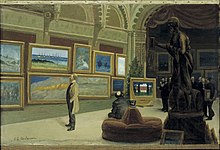Blanchs constsalong
Blanchs konstsalong was an art gallery in Stockholm .
history
Blanchs konstsalong was founded by the German-Swedish coffee house operator Theodor Blanch . After he had already created a popular meeting place for writers and artists in Stockholm with Blanchs Café , from 1879 he used the rooms behind for his own theater, the Blanchs theater . The house, which was mainly used for guest performances by foreign ensembles, suffered financial losses, which is why Blanch gave up the theater after a few years. In 1883, he converted the lavishly designed premises into a gallery, which traded as Blanchs konstsalong.
The well-connected Blanch had set himself the goal of introducing the Swedish public to works by contemporary artists from home and abroad. Right from the start he showed works by French artists such as Alphonse de Neuville , William Adolphe Bouguereau and Jean-Léon Gérôme . Later there were works by Antonio Canova , Mihály von Munkácsy , Hans Makart and Iwan Konstantinowitsch Aiwasowski . Among the Swedish artists was, for example, Julius Kronberg , who showed his well-known work Cleopatra's Death in Blanchs konstsalong.
In 1885 the exhibition Från Seinens strand ( From the beach of the Seine ) took place in Blanchs konstsalong , in which works by Swedish painters from the artists' colony in Grez-sur-Loing could be seen. The around 100 works came from 18 artists, including Carl Larsson , Anders Zorn , Nils Kreuger , Bruno Liljefors , Karl Nordström and Georg Pauli . Also in 1885 and then again in 1886, the Opponenterna artist group exhibited in Blanchs konstsalong. This group, to which painters such as August Hagborg , Per Hasselberg , Gusten Lindberg , Ernst Josephson , Carl Larsson, Eugène Jansson , Richard Bergh , Mauritz Lindström and Georg Pauli belonged, were in opposition to the policy of the Royal Academy . The academy, in turn, also used Blanch's konstsalong for an exhibition in 1887.
From 1889 the rooms of Blanchs konstsalong were permanently used by the Kunstverein Konstnärsförbundet . Theodor Blanch then mainly worked as an art dealer and died in 1911. Blanchs konstsalong existed until 1915. After that, the rooms were converted back into a theater, which existed as a Blancheteatern until the 1960s. The building was then demolished.
literature
- G. Jacobson: Theodor J Blanch: Gallerist, Konsthandlare, Restauratör . Article in Svenskt biografiskt lexikon . (Accessed November 3, 2019)
- Blanch, Teodor Julius , entry in Nordisk familjebok , 1905, p. 642. (Accessed November 3, 2019)
Individual evidence
- ^ Michelle Facos: Nationalism and the Nordic Imagination. Swedish art of the 1890s. University of California Press, Berkeley CA et al. 1998, ISBN 0-520-20626-6 , p. 16.
Coordinates: 59 ° 19 ′ 56.9 ″ N , 18 ° 4 ′ 11.5 ″ E

